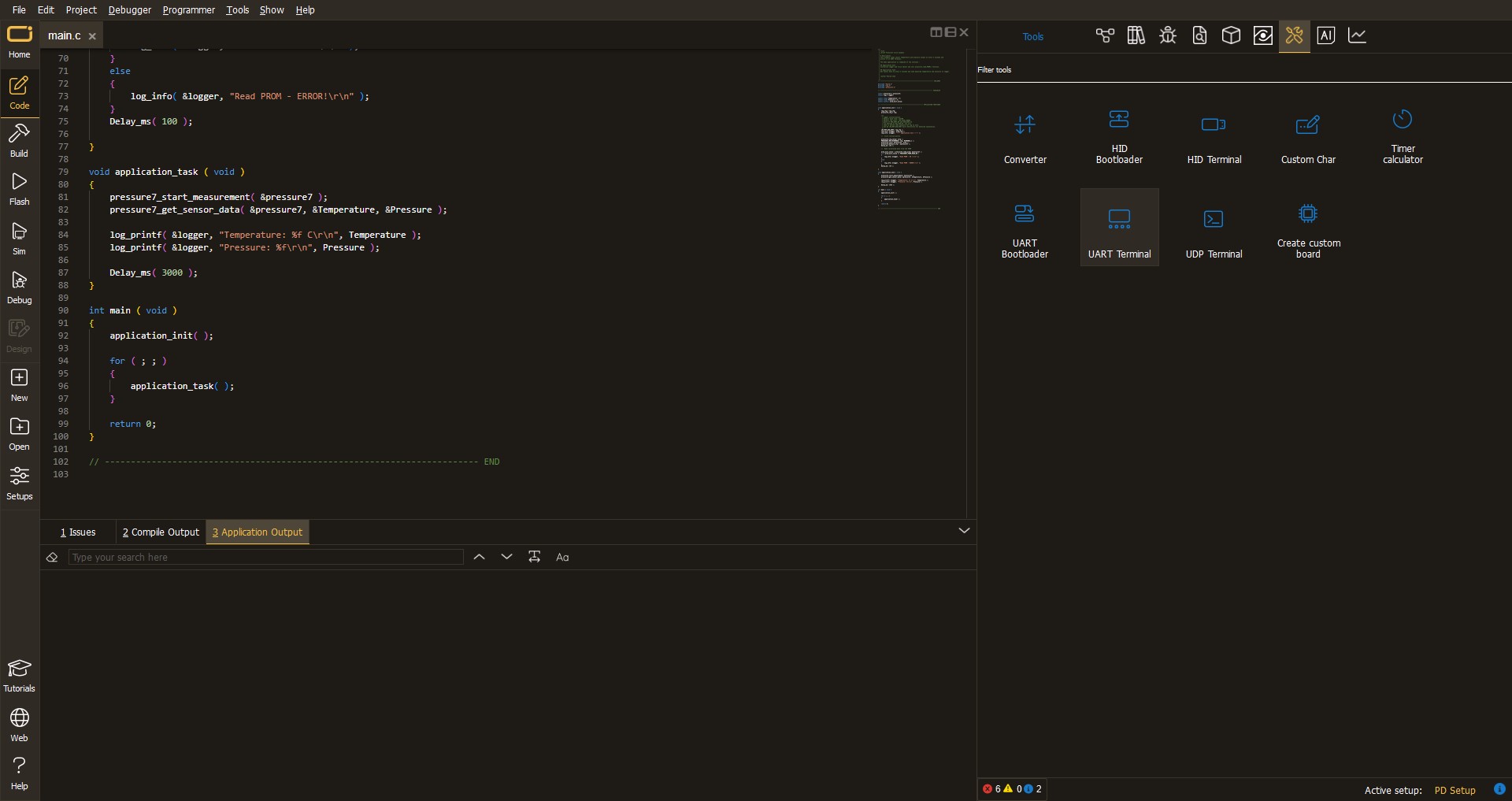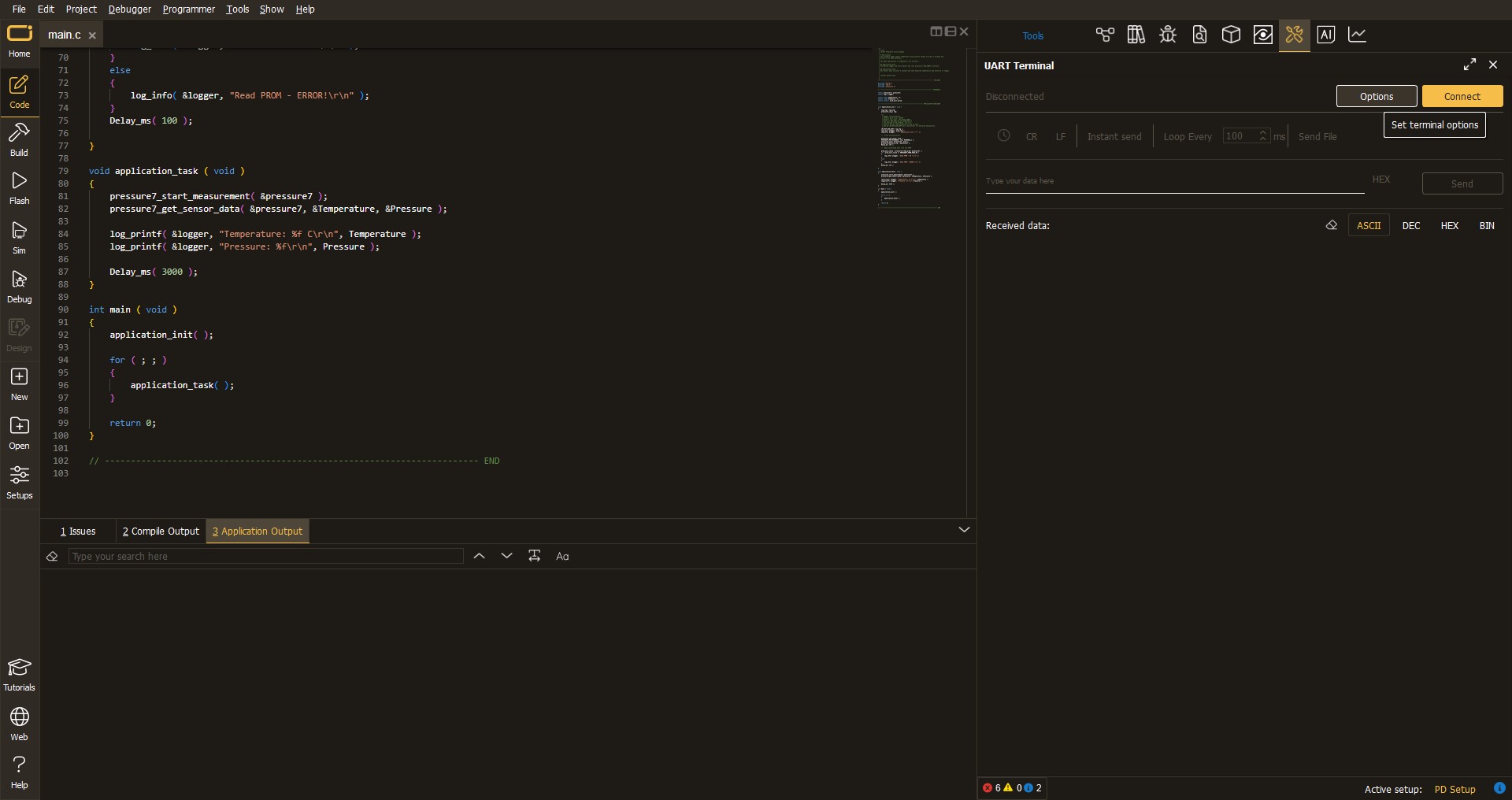Ultra-low pressure measurement solution for up to 500Pa with exceptional sensitivity and accuracy
A
A
Hardware Overview
How does it work?
Ultra-Low Press Click is based on the SM8436, a high precision, factory-calibrated pressure sensor for ultra-low pressure measurements ranging from 0 to 500Pa from TE Connectivity Measurement Specialties. It combines a low-pressure MEMS die with a 16-bit ASIC, utilizing DSP for multi-dimensional polynomial error correction. The calibrated pressure output data and status information on the sensor integrity and unique serial number are available via the digital data interface. This Click board™ represents an ideal solution for lower pressure-sensing capabilities in industrial and medical markets. From HVAC and
gas flow to continuous positive airway pressure (CPAP), ventilation, and patient monitoring applications, the ability to detect small pressure changes is critical. This demand requires the sensor to be highly accurate and provide long-term stability, which this board achieves. Ultra-Low Press Click communicates with MCU using the standard I2C 2-Wire interface with a maximum clock frequency of up to 400kHz. It is fully adjustable through software registers where the digital output data is available with a word length 16-bit. The I2C interface allows setting the SM8436 into Sleep Mode using a specific command (Enter
Sleep Mode), which confirms low consumption of typically less than 10μA. In Sleep Mode, no pressure data is acquired. To wake the sensor from its Sleep state, the clock line SCL shall be toggled (a rising edge at SCL will wake up the device). This Click board™ can operate with either 3.3V or 5V logic voltage levels selected via the VCC SEL jumper. This way, both 3.3V and 5V capable MCUs can use the communication lines properly. Also, this Click board™ comes equipped with a library containing easy-to-use functions and an example code that can be used as a reference for further development.
Features overview
Development board
EasyPIC v7a is the seventh generation of PIC development boards specially designed for the needs of rapid development of embedded applications. It supports a wide range of 8-bit PIC microcontrollers from Microchip and has a broad set of unique functions, such as the first-ever embedded debugger/programmer over USB-C. The development board is well organized and designed so that the end-user has all the necessary elements in one place, such as switches, buttons, indicators, connectors, and others. With four different connectors for each port, EasyPIC v7a allows you to connect accessory boards, sensors, and custom electronics more efficiently than ever. Each part of the EasyPIC v7a development board
contains the components necessary for the most efficient operation of the same board. In addition to the advanced integrated CODEGRIP programmer/debugger module, which offers many valuable programming/debugging options and seamless integration with the Mikroe software environment, the board also includes a clean and regulated power supply module for the development board. It can use various external power sources, including an external 12V power supply, 7-23V AC or 9-32V DC via DC connector/screw terminals, and a power source via the USB Type-C (USB-C) connector. Communication options such as USB-UART and RS-232 are also included, alongside the well-
established mikroBUS™ standard, three display options (7-segment, graphical, and character-based LCD), and several different DIP sockets. These sockets cover a wide range of 8-bit PIC MCUs, from PIC10F, PIC12F, PIC16F, PIC16Enh, PIC18F, PIC18FJ, and PIC18FK families. EasyPIC v7a is an integral part of the Mikroe ecosystem for rapid development. Natively supported by Mikroe software tools, it covers many aspects of prototyping and development thanks to a considerable number of different Click boards™ (over a thousand boards), the number of which is growing every day.
Microcontroller Overview
MCU Card / MCU

Architecture
PIC
MCU Memory (KB)
32
Silicon Vendor
Microchip
Pin count
28
RAM (Bytes)
3648
Used MCU Pins
mikroBUS™ mapper
Take a closer look
Schematic

Step by step
Project assembly
Track your results in real time
Application Output
After pressing the "FLASH" button on the left-side panel, it is necessary to open the UART terminal to display the achieved results. By clicking on the Tools icon in the right-hand panel, multiple different functions are displayed, among which is the UART Terminal. Click on the offered "UART Terminal" icon.

Once the UART terminal is opened, the window takes on a new form. At the top of the tab are two buttons, one for adjusting the parameters of the UART terminal and the other for connecting the UART terminal. The tab's lower part is reserved for displaying the achieved results. Before connecting, the terminal has a Disconnected status, indicating that the terminal is not yet active. Before connecting, it is necessary to check the set parameters of the UART terminal. Click on the "OPTIONS" button.

In the newly opened UART Terminal Options field, we check if the terminal settings are correct, such as the set port and the Baud rate of UART communication. If the data is not displayed properly, it is possible that the Baud rate value is not set correctly and needs to be adjusted to 115200. If all the parameters are set correctly, click on "CONFIGURE".

The next step is to click on the "CONNECT" button, after which the terminal status changes from Disconnected to Connected in green, and the data is displayed in the Received data field.

Software Support
Library Description
This library contains API for Ultra-Low Press Click driver.
Key functions:
ultralowpress_ready_to_read- Ready to readultralowpress_get_press- Read pressureultralowpress_get_temp- Read temperature
Open Source
Code example
This example can be found in NECTO Studio. Feel free to download the code, or you can copy the code below.
/*!
* @file main.c
* @brief UltraLowPress Click example
*
* # Description
* This application reads the serial number of the sensor. If there were
* no errors it continues reading temperature and pressure data from the sensor.
*
* The demo application is composed of two sections :
*
* ## Application Init
* Initializes host communication(UART and I2C). Reads devices serial number and logs it.
*
* ## Application Task
* Checks if data is available. When it's available it reads the temperature
* and pressure data from the sensor and logs it.
*
* @author Luka Filipovic
*
*/
#include "board.h"
#include "log.h"
#include "ultralowpress.h"
static ultralowpress_t ultralowpress;
static log_t logger;
void application_init ( void )
{
log_cfg_t log_cfg; /**< Logger config object. */
ultralowpress_cfg_t ultralowpress_cfg; /**< Click config object. */
/**
* Logger initialization.
* Default baud rate: 115200
* Default log level: LOG_LEVEL_DEBUG
* @note If USB_UART_RX and USB_UART_TX
* are defined as HAL_PIN_NC, you will
* need to define them manually for log to work.
* See @b LOG_MAP_USB_UART macro definition for detailed explanation.
*/
LOG_MAP_USB_UART( log_cfg );
log_init( &logger, &log_cfg );
log_info( &logger, " Application Init " );
// Click initialization.
ultralowpress_cfg_setup( &ultralowpress_cfg );
ULTRALOWPRESS_MAP_MIKROBUS( ultralowpress_cfg, MIKROBUS_1 );
err_t init_flag = ultralowpress_init( &ultralowpress, &ultralowpress_cfg );
if ( init_flag == I2C_MASTER_ERROR )
{
log_error( &logger, " Application Init Error. " );
log_info( &logger, " Please, run program again... " );
for ( ; ; );
}
//Serial number of sensor read
uint16_t temp_read = 0;
uint32_t serial_read = 0;
init_flag = ultralowpress_generic_read( &ultralowpress, ULTRALOWPRESS_REG_SERIAL_NUM_H, &temp_read );
serial_read = temp_read;
serial_read <<= 16;
init_flag |= ultralowpress_generic_read( &ultralowpress, ULTRALOWPRESS_REG_SERIAL_NUM_L, &temp_read );
serial_read |= temp_read;
if ( init_flag < 0 )
{
log_error( &logger, " Read" );
for ( ; ; );
}
else
{
log_printf( &logger, " > Serial number: 0x%.8LX\r\n", serial_read );
}
Delay_ms( 1000 );
log_info( &logger, " Application Task " );
}
void application_task ( void )
{
if ( ultralowpress_ready_to_read( &ultralowpress ) )
{
ultralowpress_clear_status( &ultralowpress );
float temp = ultralowpress_get_temp( &ultralowpress );
float press = ultralowpress_get_press( &ultralowpress );
log_printf( &logger, " > Temperature[ C ]: %.2f\r\n > Pressure[ Pa ]: %.2f\r\n", temp, press );
}
Delay_ms( 100 );
}
void main ( void )
{
application_init( );
for ( ; ; )
{
application_task( );
}
}
// ------------------------------------------------------------------------ END



































